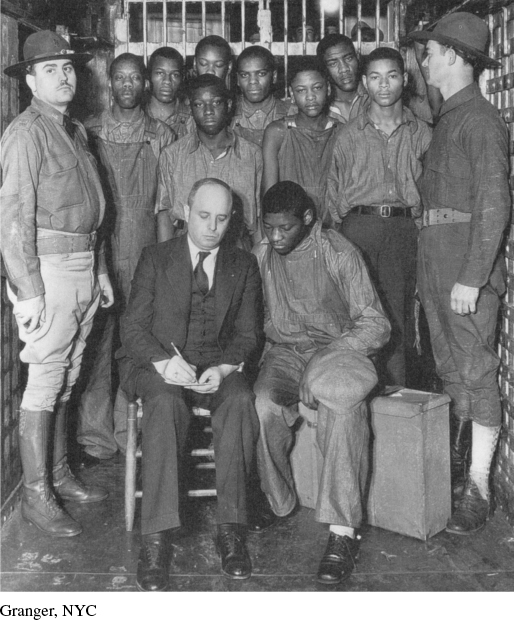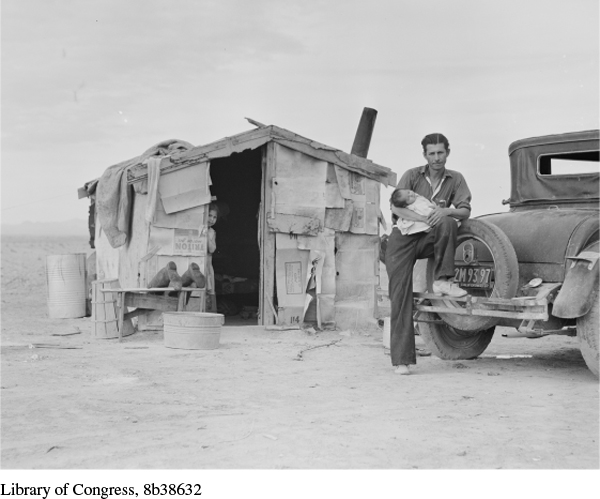Challenges for Minorities
Given the demographics of the workforce, the overwhelming majority of Americans who lost their jobs were white men; yet racial and ethnic minorities, including African Americans, Latinos, and Asian Americans, suffered disproportionate hardship. Racial discrimination had kept these groups from achieving economic and political equality, and the Great Depression added to their woes.
Traditionally the last hired and the first fired, blacks occupied the lowest rungs on the industrial and agricultural ladders. “The depression brought everybody down a peg or two,” the African American poet Langston Hughes wryly commented. “And the Negroes had but few pegs to fall.” Despite the great migration to the North during and after World War I, three-quarters of the black population still lived in the South. Mainly sharecroppers and tenant farmers, black southerners were mired in debt that they could not repay as crop prices plunged to record lows during the 1920s. As white landowners struggled to save their farms by introducing machinery to cut labor costs, they forced black sharecroppers off the land and into even greater poverty. Nor was the situation better for black workers employed at the lowest-paying jobs as janitors, menial laborers, maids, and laundresses. On average, African Americans earned $200 a year, less than one-quarter of the average wage of white factory workers.
The economic misfortune that African Americans experienced was compounded by the fact that they lived in a society rigidly constructed to preserve white supremacy. The 25 percent of blacks living in the North faced racial discrimination in employment, housing, and the criminal justice system, but at least they could express their opinions and desires by voting. By contrast, black southerners remained segregated and disfranchised by law. The depression also exacerbated racial tensions, as whites and blacks competed for the shrinking number of jobs. Lynching, which had declined during the 1920s, surged upward—in 1933 twenty-four blacks lost their lives to this form of terrorism.
Events in Scottsboro, Alabama, reflected the special misery African Americans faced during the Great Depression. Trouble erupted in 1931 when two young, unemployed white women, Ruby Bates and Victoria Price, snuck onto a freight train heading to Huntsville, Alabama. Before the train reached the Scottsboro depot, a fight broke out between black and white men on top of the freight car occupied by the two women. After the train pulled in to Scottsboro, the local sheriff arrested nine black youths between the ages of twelve and nineteen. Charges of assault quickly escalated into rape, when the women told authorities that the black men in custody had molested them on board the train.

Explore
See Document 22.1 for a letter from the Scottsboro prisoners.
The defendants’ court-appointed attorney was less than competent and had little time to prepare his clients’ cases. It probably made no difference, as the all-white male jury swiftly convicted the accused and awarded the harshest of sentences; only the youngest defendant was not given the death penalty. The Supreme Court spared the lives of the Scottsboro Nine by overturning their guilty verdicts in 1932 on the grounds that the defendants did not have adequate legal representation and again in 1935 because blacks had been systematically excluded from the jury pool. Although Ruby Bates had recanted her testimony and there was no physical evidence of rape, retrials in 1936 and 1937 produced the same guilty verdicts, but this time the defendants did not receive the death penalty—a minor victory considering the charges. State prosecutors dismissed charges against four of the accused, all of whom had already spent six years in jail. Despite international protests against this racist injustice, the last of the remaining five did not leave jail until 1950.
Racism also worsened the impact of the Great Depression on Spanish-speaking Americans. Mexicans and Mexican Americans made up the largest segment of the Latino population living in the United States. Concentrated in the Southwest and California, they worked in a variety of low-wage factory jobs and as migrant laborers in fruit and vegetable fields. The depression reduced the Mexican-born population living in the United States in two ways. The federal government, in cooperation with state and local governments and private businesses, deported around one million Mexicans, a majority of whom were American citizens. Los Angeles officials organized more than a dozen deportation trains transporting thousands of Mexicans to the border. Many others returned to Mexico voluntarily when demand for labor in the United States dried up. By 1933 the number of repatriations had begun to decline. Fewer migrants came over the border after the depression began in 1929, thereby posing less of an economic threat. In addition the Roosevelt administration adopted more humane policies, attempting not to break up families.
Those who remained endured growing hardships. Relief agencies refused to provide them with the same benefits as whites. Like African Americans, they encountered discrimination in public schools, in public accommodations, and at the ballot box. Conditions remained harshest for migrant workers toiling long hours for little pay and living in overcrowded and poorly constructed housing. In both fields and factories employers had little incentive to improve the situation because there were plenty of white migrant workers to fill their positions.

The transient nature of agricultural work and the vulnerability of Mexican laborers made it difficult for workers to organize, but Mexican American laborers engaged in dozens of strikes in California and Texas in the early 1930s. Most ended in defeat, but a few, such as a strike of pecan shellers in San Antonio, Texas, led by Luisa Moreno, won better working conditions and higher wages. Despite these hard-fought victories, the condition of Latinos remained precarious.
On the West Coast, Asian Americans also remained economically and politically marginalized. Japanese immigrants eked out livings as small farmers, grocers, and gardeners, despite California laws preventing them from owning land. Many of their college-educated U.S.-born children found few professional opportunities available to them, and they often returned to work in family businesses. The depression magnified the problem. Like other racial and ethnic minorities, the Japanese found it harder to find even the lowest-wage jobs now that unemployed whites were willing to take them. As a result, about one-fifth of Japanese immigrants returned to Japan during the 1930s.
The Chinese suffered a similar fate. Although some 45 percent of Chinese Americans had been born in the United States and were citizens, people of Chinese ancestry remained isolated in ethnic communities along the West Coast. Discriminated against in schools and most occupations, many operated restaurants and laundries. During the depression, those Chinese who did not obtain assistance through governmental relief turned instead to their own community organizations and to extended families to help them through the hard times.
Filipino immigrants had arrived on the West Coast after the Philippines became a territory of the United States in 1901. Working as low-wage agricultural laborers, they were subject to the same kind of racial animosity as other dark-skinned minorities. Filipino farmworkers organized agricultural labor unions and conducted numerous strikes in California, but like their Mexican counterparts they were brutally repressed. In 1934 anti-Filipino hostility reached its height when Congress passed the Tydings-McDuffie Act. The measure accomplished two aims at once: The act granted independence to the Philippines, and it restricted Filipino immigration into the United States.
Exploring American HistoriesPrinted Page 723
Exploring American Histories Value EditionPrinted Page 534
Chapter Timeline